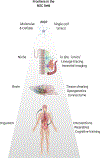Aging and Rejuvenation of Neural Stem Cells and Their Niches
- PMID: 32726579
- PMCID: PMC7415725
- DOI: 10.1016/j.stem.2020.07.002
Aging and Rejuvenation of Neural Stem Cells and Their Niches
Abstract
Aging has a profound and devastating effect on the brain. Old age is accompanied by declining cognitive function and enhanced risk of brain diseases, including cancer and neurodegenerative disorders. A key question is whether cells with regenerative potential contribute to brain health and even brain "rejuvenation." This review discusses mechanisms that regulate neural stem cells (NSCs) during aging, focusing on the effect of metabolism, genetic regulation, and the surrounding niche. We also explore emerging rejuvenating strategies for old NSCs. Finally, we consider how new technologies may help harness NSCs' potential to restore healthy brain function during physiological and pathological aging.
Copyright © 2020 Elsevier Inc. All rights reserved.
Figures





References
-
- Ahn JH, Cho H, Kim JH, Kim SH, Ham JS, Park I, Suh SH, Hong SP, Song JH, Hong YK, et al. (2019). Meningeal lymphatic vessels at the skull base drain cerebrospinal fluid. Nature 572, 62–66. - PubMed
-
- Alvarez-Saavedra M, De Repentigny Y, Yang D, O’Meara RW, Yan K, Hashem LE, Racacho L, Ioshikhes I, Bulman DE, Parks RJ, et al. (2016). Voluntary Running Triggers VGF-Mediated Oligodendrogenesis to Prolong the Lifespan of Snf2h-Null Ataxic Mice. Cell Rep 17, 862–875. - PubMed
Publication types
MeSH terms
Grants and funding
LinkOut - more resources
Full Text Sources
Other Literature Sources

